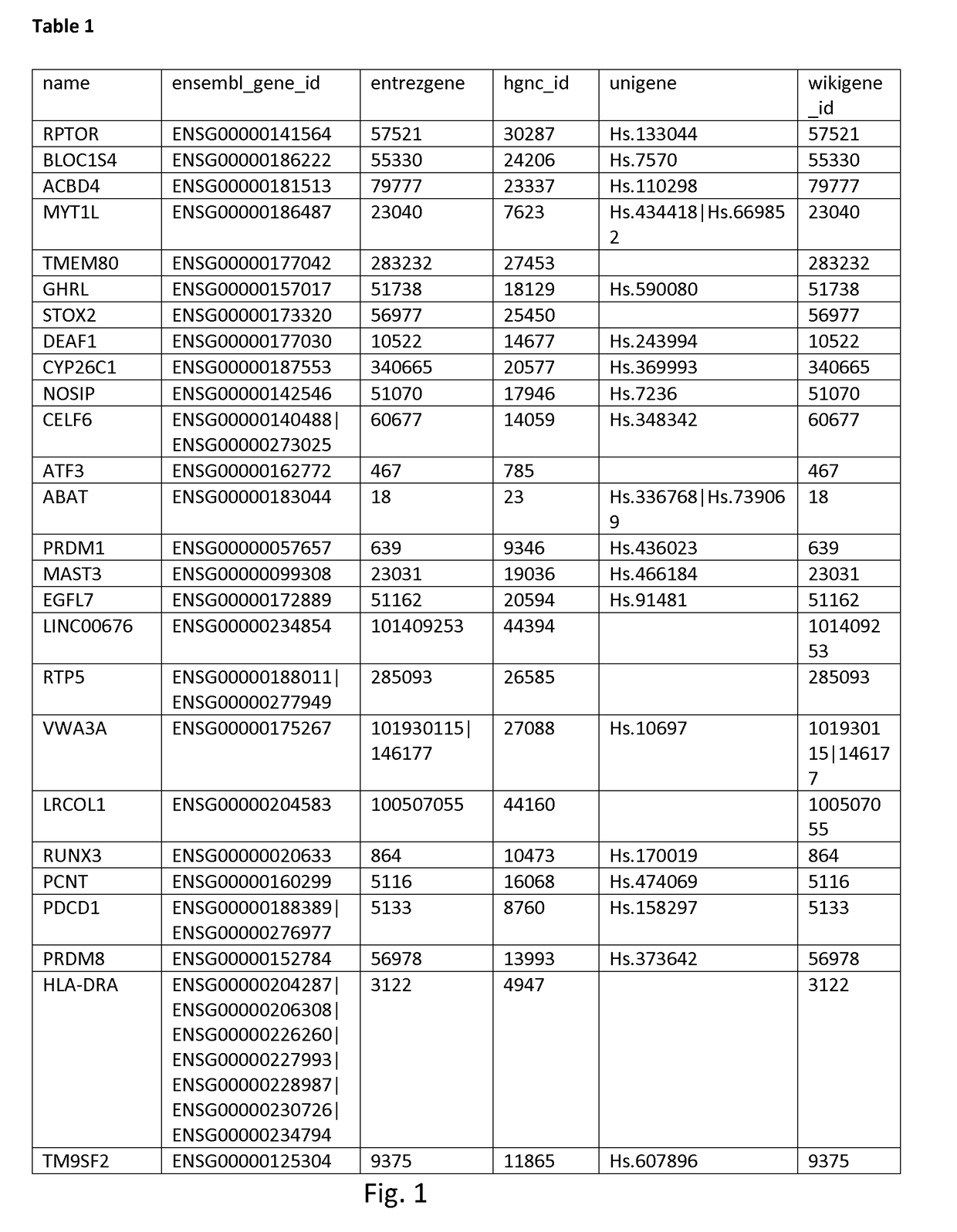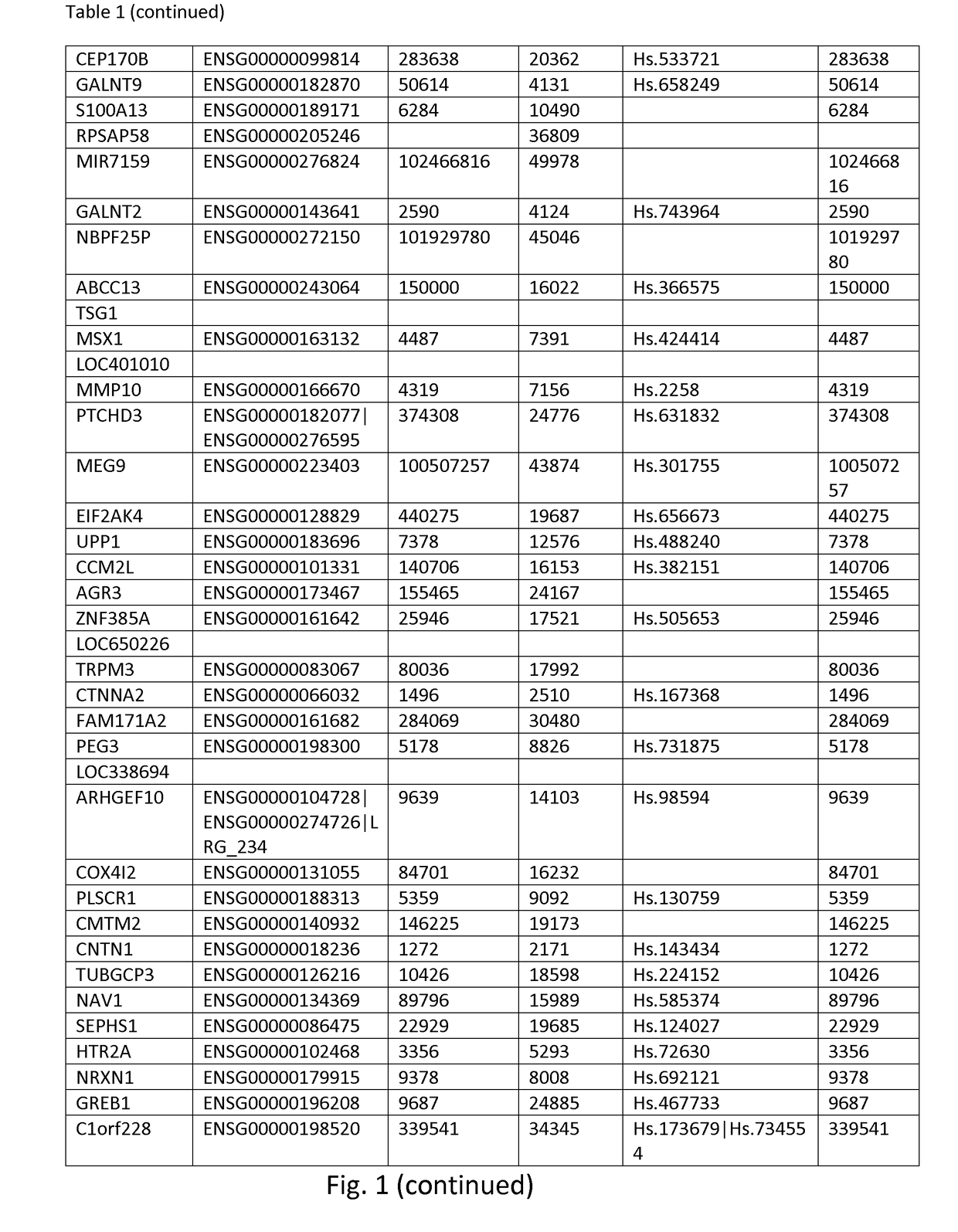Epigenetic markers for respiratory allergy
a technology of epigenetic markers and respiratory allergies, applied in the direction of microorganism testing/measurement, biochemistry apparatus and processes, etc., can solve the problems of blood sampling and the study was confined to healthy volunteers, and achieve the effect of convenient collection
- Summary
- Abstract
- Description
- Claims
- Application Information
AI Technical Summary
Benefits of technology
Problems solved by technology
Method used
Image
Examples
example 1
Comparability of Saliva and Blood DNA Methylation Patterns in Respiratory Allergy Cases
Materials and Methods
Study Design and Population
[0110]Ten adult volunteers, 5 females and 5 males, were recruited for this pilot study. 5 persons suffered from respiratory allergy (RA) and 5 individuals never showed any symptoms of RA. All volunteers completed a survey (based on the International Study of Asthma and Allergies in Children (ISAAC) (Asher et al., 1995)), including questions on: (1) occurrence and severity of RA symptoms, (2) clinical management and medical treatment and (3) family history of allergies. The study was approved by the ethical committee of the University Hospital in Antwerp (file number 13 / 2 / 22, Belgian registration number B300201316329). Before sample collection, all volunteers signed a consent form.
Sample Collection and Preparation
[0111]Blood samples (10 mL) were collected in an EDTA tube (BD Vacutainer®, BD, Plymouth, UK) from each participant and stored at room tempe...
example 2
Discovery of Diagnostic Epigenetic Markers in Saliva
Materials and Methods
Study Design and Population
[0121]The data gathered herein originate from an ongoing birth cohort in Flanders (Flanders Environment and Health Surveys FLEHS1) using the Infinium® HumanMethylation450k platform.
[0122]A case-control study design nested in a large-scale human biomonitoring surveillance programme (Flanders Environment and Health Survey FLEHS1) was used. FLESH1 was initiated in 2004 by the Flemish Centre of Expertise on Environment and Health (financed by the Flemish Government). 1200 Mother / child pairs were recruited and cord blood samples were collected At 10 years of age, 65.2% of the children developed some form of allergy, of which 13.8% respiratory allergy. A follow-up study at the age of 11 years was conducted in a subcohort (n=99) of FLEHS1, from whom lymphocyte pellets from cord blood samples were available. This subcohort was asked to confirm allergy status using a brief questionnaire, and b...
example 3
Discovery of Predictive Epigenetic Markers
Materials and Methods
[0127]The raw data obtained in Example 2 for cord blood were further processed and analyzed as described in Example 2 for identifying predictive epigenetic markers.
Results
[0128]In cord blood, 26 differently methylated regions (DMR) between respiratory allergy cases and healthy individuals were identified (Table 5, FIG. 3), of which 2 were also identified in blood and saliva samples at 11 years of age (FIG. 3).
TABLE 5Differentially methylated regions between RAcases and healthy individuals in cord blood.Hyper(+)Correspondingor Hypo (−)Chromosomal positiongenemethylationchr10: 8088800-8089733GATA3-AS1+chr10: 42862977-42863594LOC441666+chr10: 42971208-42971732LINC00839+chr10: 101287380-101287846LINC01475+chr10: 135341024-135342936CYP2E1+chr11: 123430574-123431162GRAMD1B+chr12: 31271782-31272119DDX11+chr13: 100217961-100219013TM9SF2−chr15: 53093006-53093509ONECUT1+chr16: 67997857-67998246SLC12A4+chr17: 56565285-56565644HSF5+...
PUM
| Property | Measurement | Unit |
|---|---|---|
| methylation frequency | aaaaa | aaaaa |
| nucleic acid amplification | aaaaa | aaaaa |
| area | aaaaa | aaaaa |
Abstract
Description
Claims
Application Information
 Login to View More
Login to View More - R&D
- Intellectual Property
- Life Sciences
- Materials
- Tech Scout
- Unparalleled Data Quality
- Higher Quality Content
- 60% Fewer Hallucinations
Browse by: Latest US Patents, China's latest patents, Technical Efficacy Thesaurus, Application Domain, Technology Topic, Popular Technical Reports.
© 2025 PatSnap. All rights reserved.Legal|Privacy policy|Modern Slavery Act Transparency Statement|Sitemap|About US| Contact US: help@patsnap.com



